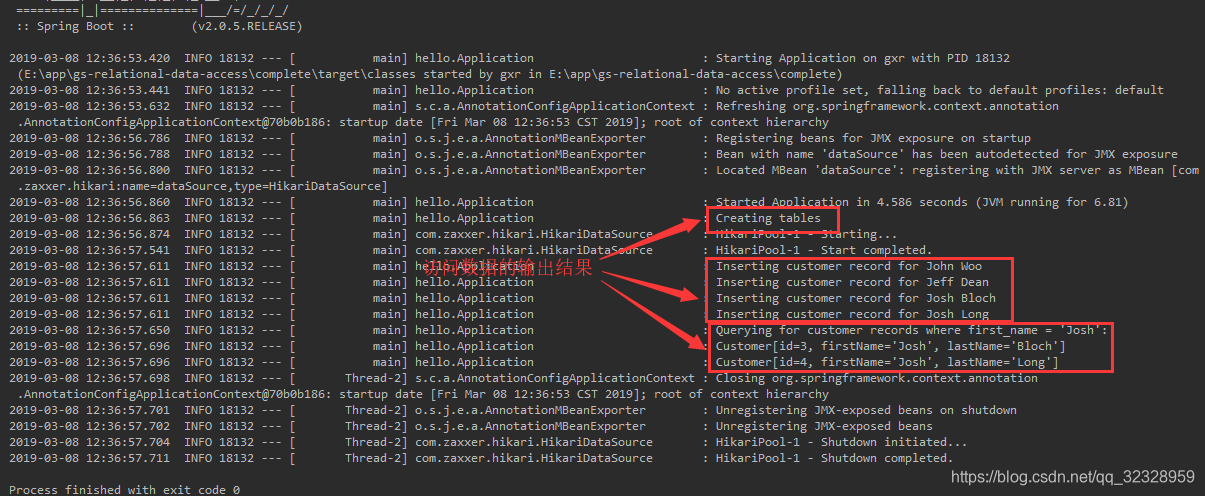参考官方文档:https://spring.io/guides/gs/relational-data-access
环境:IDEA、Java8、maven、springboot
实践内容:使用JDBC访问关系数据
pom.xml 配置文件的依赖:JDBC、H2内存数据库
<dependencies>
<dependency>
<groupId>org.springframework.boot</groupId>
<artifactId>spring-boot-starter-jdbc</artifactId>
</dependency>
<dependency>
<groupId>com.h2database</groupId>
<artifactId>h2</artifactId>
</dependency>
</dependencies>
首先创建一个实体类。
package hello;
public class Customer {
private long id;
private String firstName, lastName;
public Customer(long id, String firstName, String lastName) {
this.id = id;
this.firstName = firstName;
this.lastName = lastName;
}
@Override
public String toString() {
return String.format(
"Customer[id=%d, firstName='%s', lastName='%s']",
id, firstName, lastName);
}
// getters & setters omitted for brevity
}
然后创建一个主类。
此类中进行存储和检索数据:Spring提供了一个名为的模板类JdbcTemplate,可以轻松使用SQL关系数据库和JDBC。大多数JDBC代码都陷入资源获取、连接管理、异常处理和一般错误检查之中,这与代码要实现的内容完全无关。JdbcTemplate将负责这一切。
@SpringBootApplication
public class Application implements CommandLineRunner {
private static final Logger log = LoggerFactory.getLogger(Application.class);
public static void main(String args[]) {
SpringApplication.run(Application.class, args);
}
@Autowired
JdbcTemplate jdbcTemplate;
@Override
public void run(String... strings) throws Exception {
log.info("Creating tables");
jdbcTemplate.execute("DROP TABLE customers IF EXISTS");
jdbcTemplate.execute("CREATE TABLE customers(" +
"id SERIAL, first_name VARCHAR(255), last_name VARCHAR(255))");
// Split up the array of whole names into an array of first/last names
List<Object[]> splitUpNames = Arrays.asList("John Woo", "Jeff Dean", "Josh Bloch", "Josh Long").stream()
.map(name -> name.split(" "))
.collect(Collectors.toList());
// Use a Java 8 stream to print out each tuple of the list
splitUpNames.forEach(name -> log.info(String.format("Inserting customer record for %s %s", name[0], name[1])));
// Uses JdbcTemplate's batchUpdate operation to bulk load data
jdbcTemplate.batchUpdate("INSERT INTO customers(first_name, last_name) VALUES (?,?)", splitUpNames);
log.info("Querying for customer records where first_name = 'Josh':");
jdbcTemplate.query(
"SELECT id, first_name, last_name FROM customers WHERE first_name = ?", new Object[] { "Josh" },
(rs, rowNum) -> new Customer(rs.getLong("id"), rs.getString("first_name"), rs.getString("last_name"))
).forEach(customer -> log.info(customer.toString()));
}
}
- @SpringBootApplication注解中包含了以下注解:
- @Configuration 标记该类作为应用程序上下文的bean定义的来源。
- @EnableAutoConfiguration 告诉Spring Boot开始根据类路径设置,其他bean和各种属性设置添加bean。
- @ComponentScan告诉Spring在包中寻找其他组件,配置和服务hello。在这种情况下,没有任何。
- 因为我们使用的是spring-jdbc,所以Spring Boot会自动创建一个JdbcTemplate对象,@Autowired注解标记的jdbcTemplate字段自动加载它并使其可用。
- jdbcTemplate.batch()中使用?的参数,以避免SQL注入攻击通过指示JDBC来绑定变量。
启动运行

ps:虚心求教。如果内容有误欢迎指出,如果内容帮助了你欢迎留下痕迹。